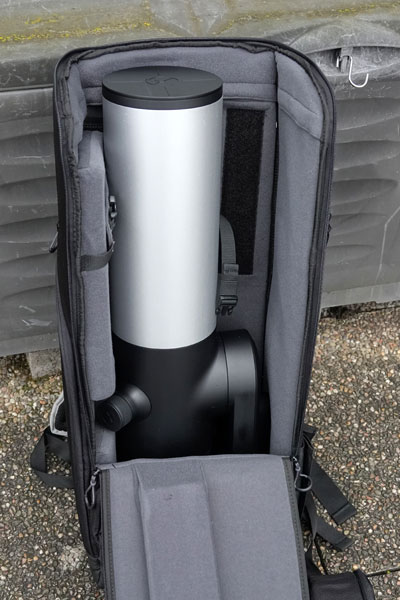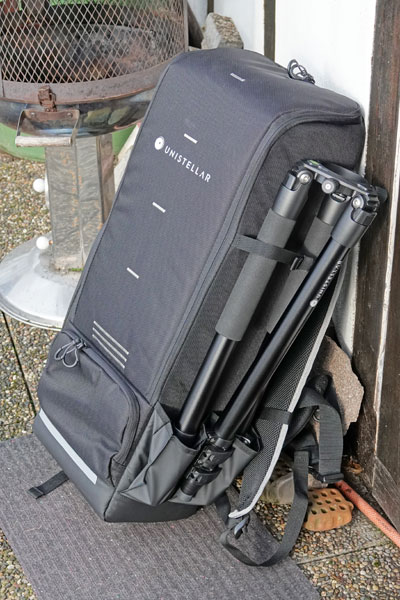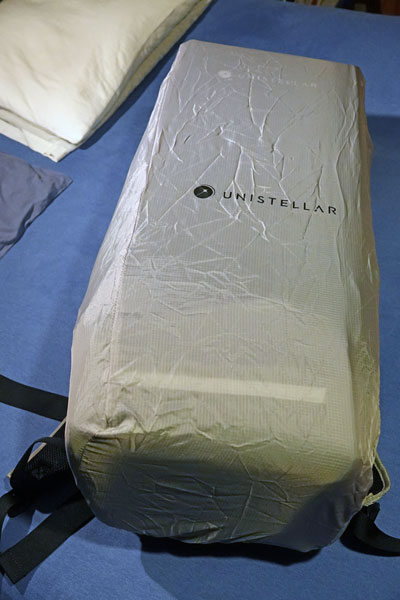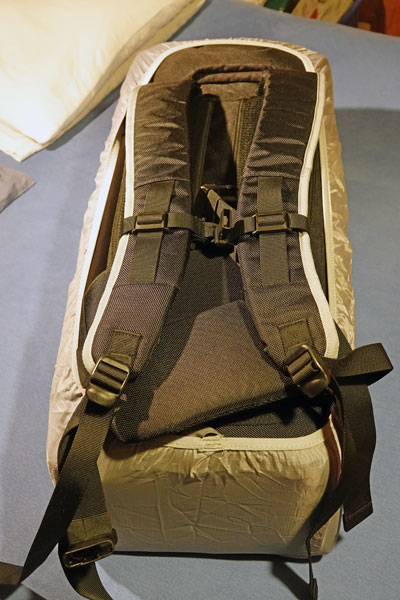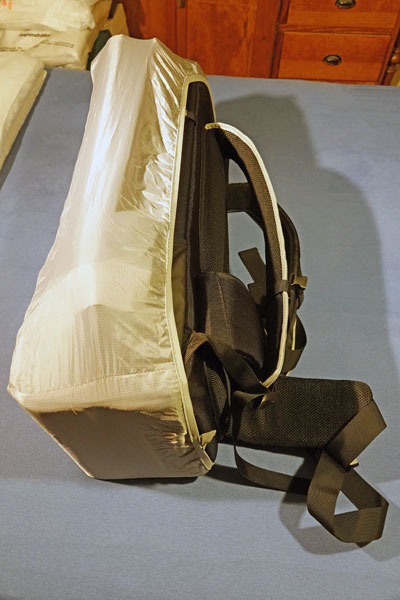Unistellar eVscope: Selected/Adapted Questions from the Unistellar FAQ/Help Center
Introduction | Overview of the Questions | Selected/Adapted Questions from the Unistellar FAQ | Links
Archive
On this page I present selected/adapted questions from the Unistellar FAQ (Kickstarter) and from the Unistellar Help Center Base (Unistellar Website) regarding my electronic 4,5" Newton telescope Unistellar eVscope 112 mm/450 mm (f/4).
Note: See page Overview of the Unistellar Pages for just that!
Introduction
I selected the original questions from the FAQ of the eVscope Kickstarter campaign (only the ones that interest me most...) and answered them using the answers provided there and a bit of my own knowledge. Since Unistellar created a help center on their own Website, the Kickstarter FAQ grew "old," and I collected further questions that I find interesting from their help center (Unistellar Help Center). Again, I allowed my self to adapt the answers (and maybe also the questions...) to my needs.
In addition, I tried to sort the questions according to topics.
In any case, I highly recommend reading the original FAQ and visiting the Unistellar Help Center.
Note: Many of the answers refer to app version 1.0, which was superseeded by version 2.0 in summer 2022.
Overview of the Questions
Troubleshooting, Maintenance
- Question: My eVscope does not start up
- Question: The eVscope app behaves erratically, crashes often, does not work as expected, etc.
- Question: Why am I not able to charge my eVscope? (section Battery)
- Question: How Can I Collimate the eVscope?
Telescope, General Questions
- Question: Why don't you offer a larger telescope with a bigger primary mirror?
- Question: Why don’t you offer a magnification of 225 x?
- Question: Can I use the telescope in cities, how sensitive is the eVscope to light pollution?
- Question: Is the eVscope good for planets?
- Question: What is the field of view and the pixel scale of the eVscope/eVscope 2?
- Question: What is the resolution of the images that the eVscope/eQuinox captures?
- Question: Can I adapt a DSLR (or system) camera to the eVscope?
- Question: What is the recommended temperature range for my eVscope?
- Question: What are the differences between the original eVscope, the eVscope eQuinox, and the eVscope 2?
- Question: Can I use other tripods with the eVscope (2)?
Eypiece
- Question: Can we switch to a different eyepiece?
- Question: How can I adapt the eyepiece to my eyes/get the image in the eyepiece sharp?
Battery
- Questions: Battery: How long does it last? Can I use the eVscope while it is charging? How do I know it's fully charged?
- Question: Why am I not able to charge my eVscope?
- Questions: Can the battery be replaced?
- Question: Can I use a power bank?
Operation, Observation
- Question: How do I get started? Do you have any user guide or instructions available?
- Question: What do LED colors at the On/Off switch mean?
- Question: The observations are in real time, right? But you seem to combine multiple frames to get a better image quality - how do you this?
- Question: How do I prepare the eVscope for observation?
- Question: What is the alignment procedure?
- Question: How do I observe with the eVscope, what are its working modes?
- Question: Is there a multi user mode on the eVscope?
- Question: Should I thermalize my eVscope?
- Question: "Enhanced Vision Stopped or Dropped": What does it mean?
Backpack
Selected/Adapted Questions from Unistellar FAQ/Help Center
Troubleshooting, Maintenance
Question: My eVscope does not start up
My eVscope did not start reliably at the beginning. This could be seen from the fact that the LED indicator around the power switch did not change to red but remained purple, instead (no WiFi as well...). The cause of this problem was a defective miniSD card, which had to be replaced. I do not know how many eVscopes were affected by this problem, but even in summer 2020 I learned that an eVscope owner had this problem.
In this case you should immediately contact the Unistellar support (mail to: support@unistellaroptics.com). Normally, you will receive a replacement card quickly (but in certain countries there may be problems or delays). Please note that you need special Torx keys to open the eVscope.
My experiences regarding this issue: Unistellar eVscope - First Experiences
Question: The eVscope app behaves erratically, crashes often, does not work as expected, etc.
In the beginning, the eVscope app behaved absolutely chaotic (app version 0.9x). Improvements came with version 1.0 in March 2020 and especially with version 1.0.5, without me calling the app "stable" so far. So if the eVscope app behaves chaotic, strange, or otherwise different than expected, I recommend first of all to check, which version number the app has. Even in September 2020, eVscopes still seem to have been shipped with the app version 1.0 (by whomever...). If you have an older app version, you should update to the current version (December 2021: 1.5.0) immediately!
Question: How Can I Collimate the eVscope?
According to Unistellar, collimation proved to be extremely robust on the prototype. Unistellar therefore expects that collimation will be done at the manufacturing plant once and then last for many years to come. However, a key is provided to adjust collimation by acting on two screws, should that happen to be necessary.
The collimation procedure is described in the Unistellar Help Center and on my Tip and Tricks page.
Telescope, General Questions
Question: How do I get started? Do you have any user guide or instructions available?
Upon arrival of your eVscope, you will find a printed version of the eVscope Quick Start Guide and Technical Guide in your box, in English. For the users' convenience, Unistellar decided to also offer PDF versions of both in English and French that are ready to be printed:
- Quick Start Guide English.pdf (4 MB) - Quick Start Guide Français.pdf (4 MB)
- Tech Guide EN3.pdf (600 KB) - Tech Guide FR3.pdf (10 MB)
There is also a video tutorial in English (French subtitles available as well, more videos to come).
Question: Why don't you offer a larger telescope with a bigger primary mirror?
On the one hand, because telescope and sensor are a perfect match, and, on the other hand, because atmospheric turbulence limits the resolution, so that a diameter of less than 200 mm is optimal for most sites. Additionally, a 4.5" telescope can be carried around.
Question: Why don’t you offer a magnification of 225 x?
For Newtonian telescopes (reflectors), it is not recommended to go beyond a factor of 1.5 with respect to the diameter of the primary mirror in mm (114.3 x 1.5 = about 170 x). A magnification of 225 x corresponds to a factor of 2 x, which is often used in advertisements, but applicable only to refractors and, for example, Maksutov-Cassegrain telescopes.
Update: There is no setting in the app to select the magnification. However, you can switch between 1 x (50 x?) and 3 x (150 x?) scale by double-tapping the image. By gesture you can even enlarge the image up to 8 x (400 x?).
Question: Can I use the telescope in cities, how sensitive is the eVscope to light pollution?
Most of the Unistellar demos were done in highly light-polluted areas. The image quality will not be as good if light pollution is high, since the fainter objects will tend to disappear below the light pollution threshold, but you will still see colors and details on many of the brighter nebulae, galaxies, asteroids etc. Unistellar states that staying away from street lights (that is, by going behind a building or trees) is sufficient to enjoy objects like, for example, M 27 (Dumbbell Nebula), M 57 (Ring Nebula), or M 51 (Whirlpool Galaxy).
In its Quick Start Guide, however, Unistellar states unmistakably: "For better results, avoid a full moon." I can confirm this from my own experience, particularly if you are aiming at high-quality photos and not at pure observation (see page Tips & Tricks > Should I Refrain from Observing During a Full Moon?).
Question: Is the eVscope good for planets?
The eVscope is not designed to provide stunning images of Venus, Mars, Jupiter and Saturn, particularly, because of its relatively low magnification (or short focal length). A Maksutov-Cassegrain telescope like my Skymax-102 or Skymax-127 is much better suited to this task. You can, however, see the planets and distinguish some of their structures (ring of Saturn, satellites, phase of venus) with it. Using the eVscope, you can also see the fainter planets like Pluto, Uranus and Neptune, which are difficult to pinpoint and see with a classical telescope.
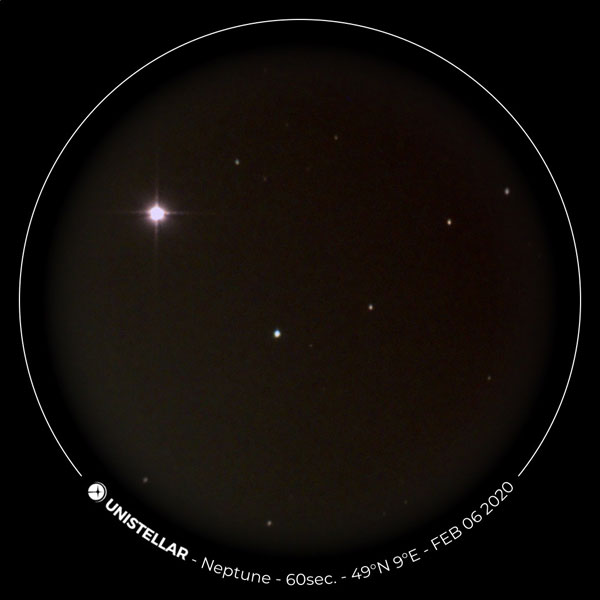 |
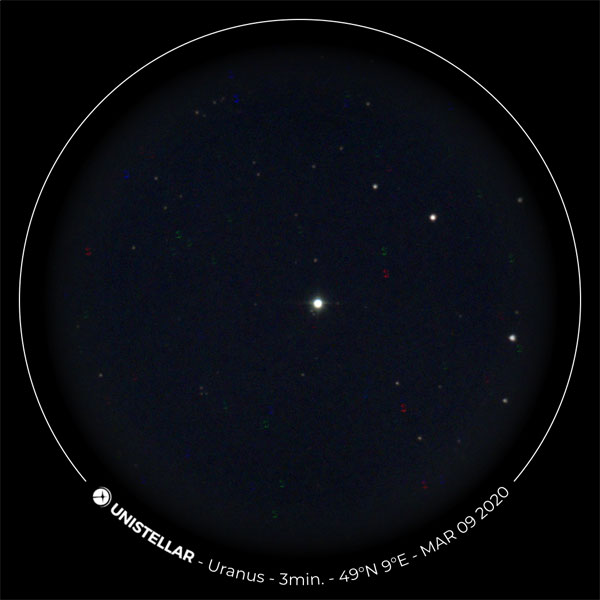 |
|
Neptune - Feb 6, 2020 |
Uranus - March 9, 2020 |
Photos: Neptune and Uranus photographed with the eVscope
Question: What is the field of view and the pixel scale of the eVscope/eVscope 2?
eVscope/eVscope eQuinox
The field of view is 27 arcmin x 37 arcmin (about the diameter of the moon or sun), the pixel scale is 1.7 arcsec (exactly: 1.72").
My own calculations lead, however, to a field of view of 36,7' (0,61°) horizontally and 27,6' (0,46°) vertically. The full moon can therefore only be fully captured in its width, but not in its height.
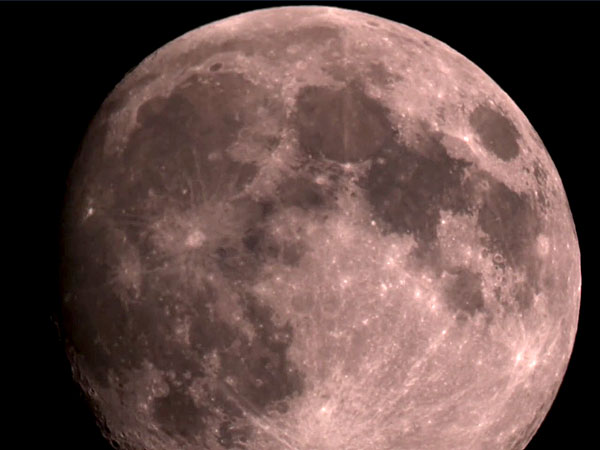 |
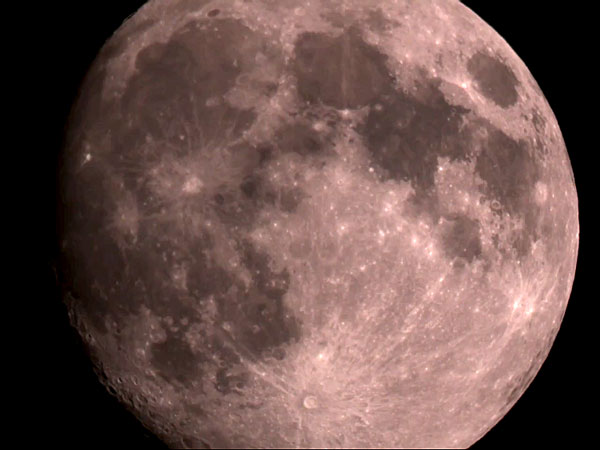 |
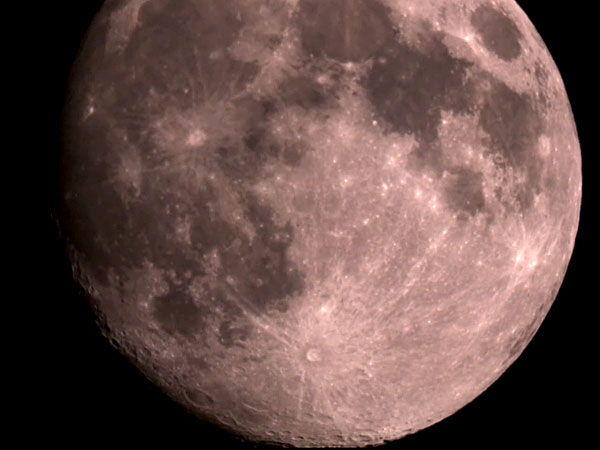 |
||
Nearly Full Moon - May 5, 2020; original |
Nearly Full Moon - May 5, 2020; original |
Nearly Full Moon - May 5, 2020; original |
Photos: Nearly full moon photographed with the eVscope in Live View mode
eVscope 2
The new eVscope 2 can fully capture the moon (FOV: 34 arcmin x 47 arcmin; pixel scale: 1.33).
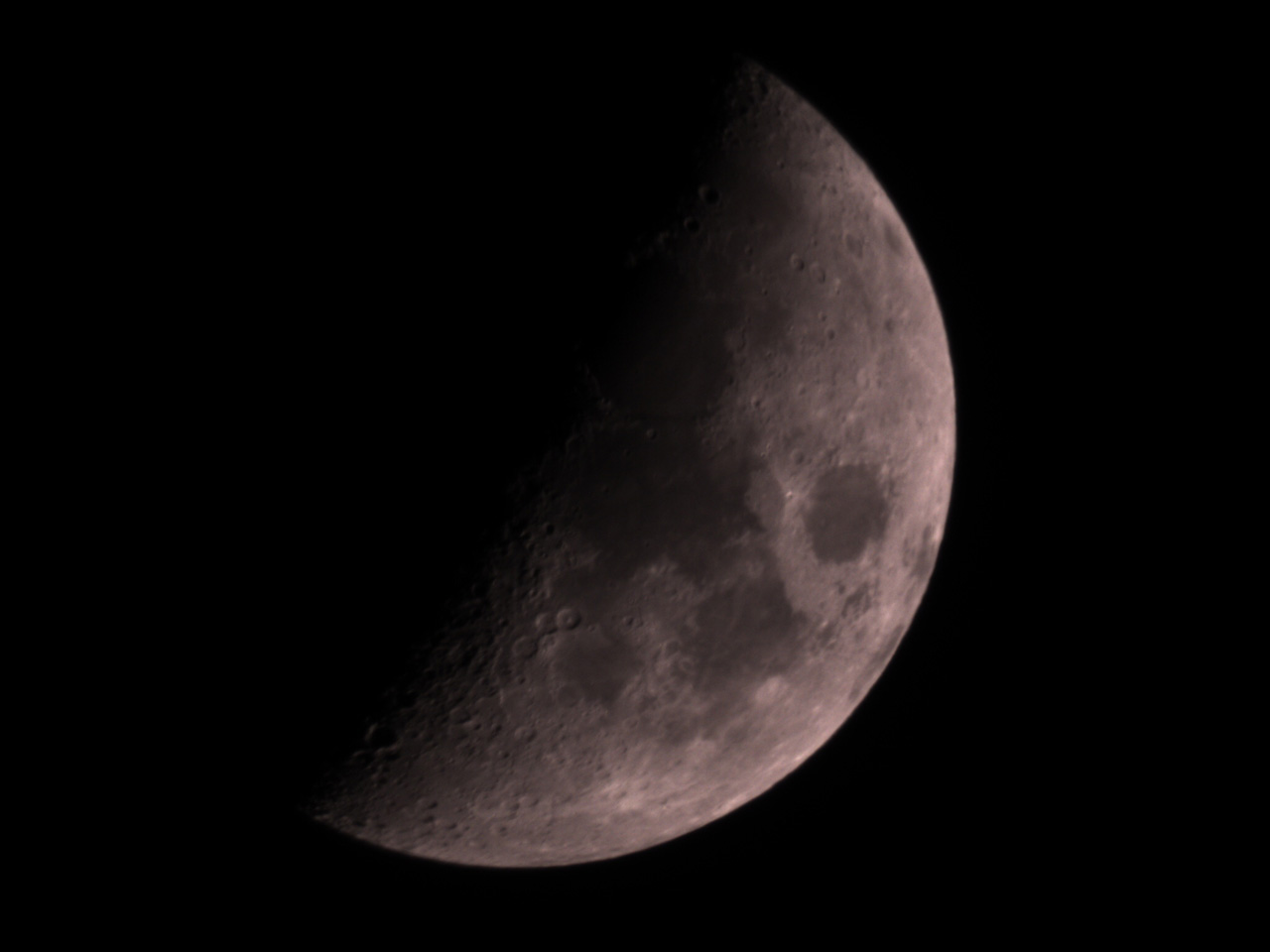 |
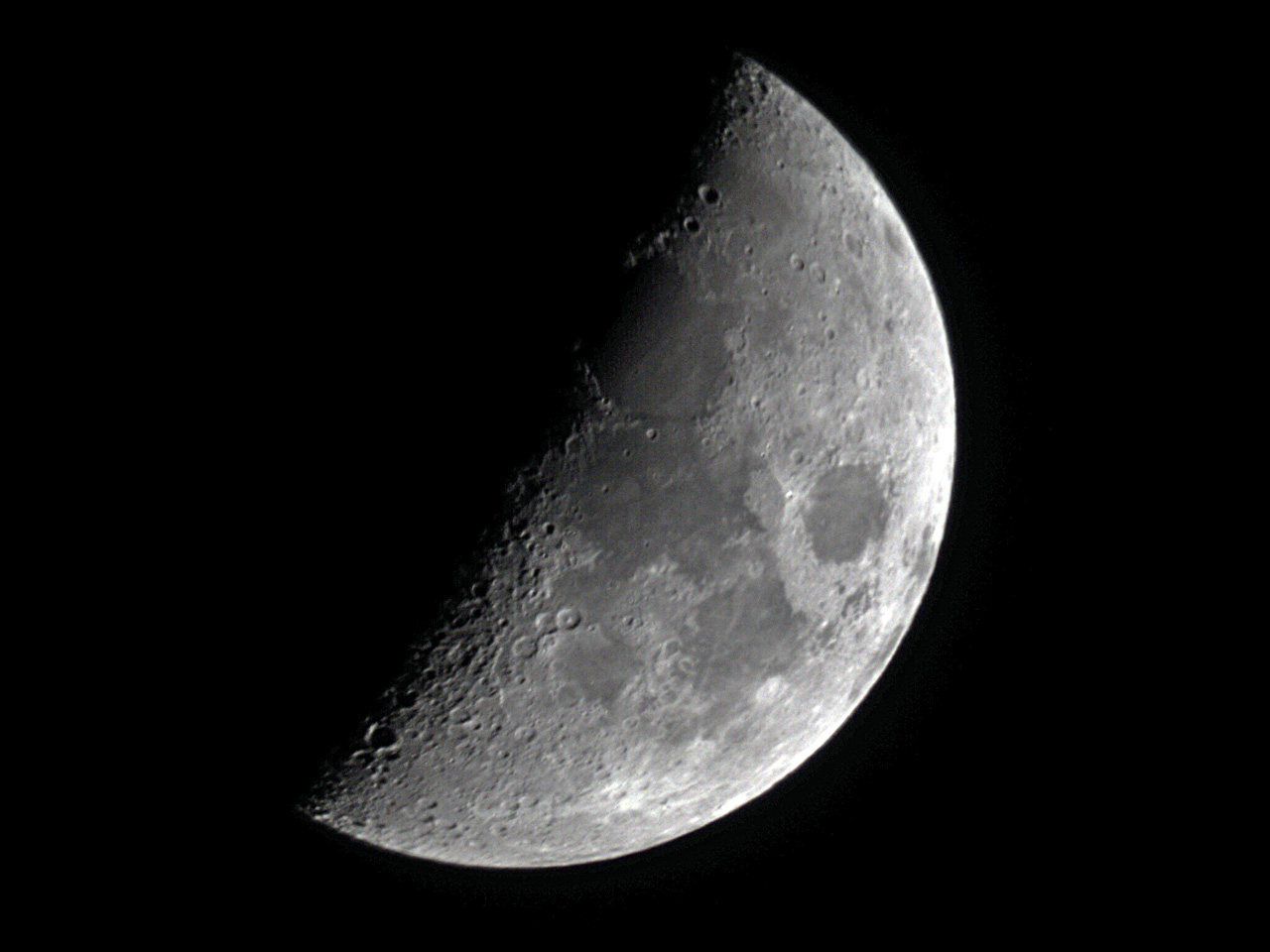 |
|
Moon - eVscope 2, Dec 10, 2021, unprocessed (original size) |
Moon - eVscope 2, Dec 10, 2021, photo left processed (original size) |
Question: What is the resolution of the images that the eVscope/eQuinox 2 captures?
eVscope/eQuinox
- The Sony IMX224LQR image sensor has a raw image size of 1305 x 977 pixels and a typical frame rate of 60 fps. It has square pixels of 3.75 µm x 3.75 µm.
- However, the eVscope uses it with a resolution of 1280 x 960 pixels (alternative sensor mode); since app version 1.3, the image is upscaled to 2560 x 1920 pixels in Enhanced Vision mode (4.9 Megapixels).
eVscope 2
- The Sony IMX347 image sensor has a raw image size of 2712 x 1536 pixels. It has square pixels of 2.9 µm x 2.9 µm.
- However, the eVscope uses it with a resolution of only 2048 x 1536 pixels; in Enhanced Vision mode, the image is upscaled to 3200 x 2400 pixels (7.7 Megapixels).
eQuinox 2
- The Sony IMX347 image sensor has a raw image size of 2712 x 1536 pixels. It has square pixels of 2.9 µm x 2.9 µm.
- However, the eQuinox 2 uses it with a resolution of only 2048 x 1536 pixels; in Enhanced Vision mode, the image is upscaled to 2875 x 2156 pixels* (6.2 Megapixels).
*) Estimated values
Question: Can I adapt a DSLR (or system) camera to the eVscope?
The CCD sensor is a fundamental ingredient of the eVscope, and the telescope is matched optimally to its size (therefore, a 4.5" Newton reflector was chosen). According to Unistellar, this design provides the best combination of resolution and sensitivity. It therefore does make little or no sense to replace the sensor with another one (i.e. with the one in the DSLR). For a DSLR you would probably chose a bigger telescope as the one used in the eVscope. Here, a small telescope was chosen for the reasons listed above, and also to keep size and weight low in order to create a portable telescope.
One might hold a camera to the eyepiece (as did the founders sometimes during their demos), but it is easier and leads to better image quality if you receive the images with your smartphone or tablet computer.
Question: What is the recommended temperature range for my eVscope?
We recommend the following temperature range (° Celsius) for your eVscope:
- storage: -15°C -> +60°C (recharge your battery regularly if storage > 2 months)
- storage and recharge: 10°C -> +40°C
- observation and recharge: 10°C -> +40°C
- observation: -10°C -> +40°C
While using it in a very cold environment, we recommend covering it to provide relative insulation. The main effect of the cold will be a faster draining of the battery.
Question: What are the differences between the original eVscope, the eVscope eQuinox, and the eVscope 2?
The differences between the models (the original eVscope is no longer available) are described in the table below (from Unistellar Help Center: eQuinox VS eVscope 1.0 VS eVscope 2), to which I added some information:
| Specifications | eQuinox | eVscope 1 | eVscope 2 |
| Battery Life | up to 12h (no eyepiece) |
up to 10h | up to 10h |
| µSD Storage Capacity | 64GB | 16GB | 64GB |
| Display | OLED screen | OLED screen | OLED screen |
| HARDWARE | |||
| Optical Magnification: 50x | ✔ | ✔ | ✔ |
| Digital Magnification: up to 400x (150x recommended maximum) | ✔ | ✔ | ✔ |
| Field of View | 27 arcmin x 37 arcmin | 27 arcmin x 37 arcmin | 34 arcmin x 47 arcmin |
| Max Magnitude: <16 in the medium quality night sky in under a minute, up to 18 in excellent conditions in a few minutes | ✔ | ✔ | ✔ |
| Resolving Power (Image Scale) | 1.72 arcsec | 1.72 arcsec | 1.33 arcsec |
| Mirror Diameter: 4.5" | ✔ | ✔ | ✔ |
| Focal Length: 450 mm | ✔ | ✔ | ✔ |
| Motorized Alt-Az Mount with extreme tracking accuracy thanks to Automated Celestial Tracking with Feedback | ✔ | ✔ | ✔ |
| Weight: 19.8 lbs (9 kg) including tripod | ✔ | ✔ | ✔ |
| ELECTRONICS | |||
| Sensor Technology: Sony Exmor with NIR technology | ✔ | ✔ | ✔ |
| Sensor Model | IMX224 | IMX224 | IMX347 |
| Pixel Size | 3.75 x 3.75 µm | 3.75 x 3.75 µm | 2.9 x 2.9 µm |
| Pixels | 1280 x 960 | 1280 x 960 | 2048 x 1536* |
| Megapixels | approx. 1.23** | approx. 1.23** | approx. 4.09** |
| eVscope Pixels in EV Mode (since app version 1.3/1.4) | 2560 x 1920 | 2560 x 1920 | 3200 * 2400* |
| eVscope Megapixels in EV Mode (since App Version 1.3/1.4) | 4.9* | 4.9* | 7.7* |
*) according to Unistellar; **) according to Sony; more on the eVscope on page Unistellar eVscope - Information (4.5" Newton)!
Question: Can I Use Other Tripods with the eVscope (2)?
The eVscope (2) comes with its own custom-made tripod, which has sometimes been criticized for not being stable enough. So the question arises, whether the eVscope (2) can also be used at other tripods, particularly more sturdier ones. In June 2022, I got an e-mail from a, probably Italian, eVscope user sharing the information that the eVscope can be used with some Gitzo tripods. He wrote: There are two flat top plate sizes, about 7.5 cm for series 2, 3, and 4, and larger for Series 5. The eVscope has a diameter of about 7 cm at the base, so it fits up to Series 4, for example, with the G1348, that the user owns (but not with his G55 series tripod).
Eypiece
Question: Can we switch to a different eyepiece?
The eVscope's eyepiece is not a "normal" eyepiece that receives an image that is created by the telescope with purely optical means. The image is received by a CCD sensor and is processed by software. The result is sent to a small OLED "screen" that is viewed with the eVscope's eyepiece (that is, in reality we have something like an electronic viewfinder in a digital camera). It therefore does not make any sense to replace the eyepiece, which is optimally adapted to its purpose. The different magnifications of the telescope (50 x, 100 x, 150 x) are created purely digitally.
Question: How can I adapt the eyepiece to my eyes/get the image in the eyepiece sharp?
By rotating the eyepiece, the image in the eyepiece can be adapted to one's eyes, i.e. brought into focus. Originally, the eyepiece is screwed in completely, and you have to turn it counterclockwise out (it can be very tight at the beginning). After a few turns, the eyepiece hits a stop again, so it cannot be turned out completely. So the focusing range lies in between.
Since app version 1.0, there is also an eypiece focus helper, which displays a pattern in the eypiece to make adapting focus of the eyepiece easier. It turns off automatically after 1 minute (a timer is displayed in the app).
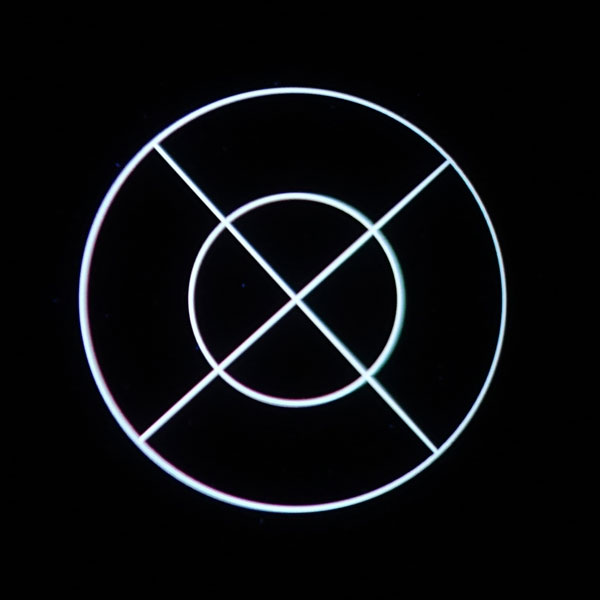 |
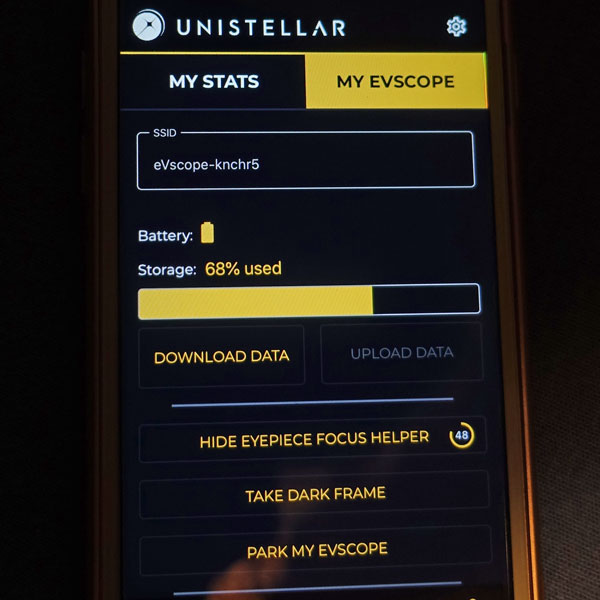 |
|
The eypiece focus helper: a pattern is displayed in the eyepiece that can be used for focusing |
The timer for the eyepiece focus helper (to the right of the button text) |
Battery
Questions: Battery: How long does it last? Can I use the eVscope while it is charging? How do I know it's fully charged?
The eVscope's battery lasts up to 10 hours (9 hours according to the technical manual). You can also use your telescope while its battery is charging. The charging time can vary from 6.5 hours (OFF mode) to 8 hours (while operating).
To charge the battery, you have to use a USB-C charger (you'll hear a click when you'll connect it). The LED will be blue and it will go from one to six flashes. Flashes increase as the battery gets more charged. In the end, the LED will show blue for 1.9 sec, and a very quick flash during 0.1 sec. That's how you know your battery is fully charged. Also, the app will show a full battery icon.
>> The italic text seems to be wrong. The LED flashes blue once per second when the battery is fully charged (as stated elsewhere in the Unistellar Help Center -> see LED colors).
Question: Why am I not able to charge my eVscope?
According to Unistellar (Yann) there is a built-in mechanism that prevents the battery from being charged when the temperature is too low (according to Unistellar, charging the battery below 5°C can sometimes cause damage; the technical manual recommends not to charge below 10°C).
With version 1.0. of the app, you should be able to charge and use the eVscope even at low temperatures (Unistellar has done many tests with version 1.0. at very low temperatures, even at -20°C, and the results are much better). So far, however, the above-mentioned values for the recommended temperature range have not been changed in the Help Center, and I have not experienced any changes after installing app version 1.0.0. The information for this update, however, promises an improved battery performance in cold weather.
Question: Can the battery be replaced?
The telescope, its electronics, and sensors are powered with a rechargeable internal battery that can be replaced in case of malfunction or permanent damage. The technical manual, however, states that the battery is not meant to be replaced by the user!
Question: Can I use a power bank?
Yes, you can absolutely use a power bank to charge your eVscope. Any would do provided it is USB 5V, Unistellar recommends those delivering at least 2 A. 2000 mAh gives approximately +1 hour. Also, please use a good quality charging cable.
Operation, Observation
Question: How do I get started? Do you have any user guide or instructions available?
Upon arrival of the (original) eVscope, a printed version of the eVscope Quick Start Guide and Technical Guide in English can be found in the box. For the convenience of users, Unistellar also provides PDF versions of these in English and French:
- Quick Start Guide English.pdf (4 MB) - Quick Start Guide Français.pdf (4 MB)
- Tech Guide EN3.pdf (600 KB) - Tech Guide FR3.pdf (10 MB)
There is also a video tutorial in English (French subtitles are also available, more videos to follow).
Update: In the Unistellar Help Center there is an article with exactly this title (How do I get started? Do you have any user guide or instructions available?) available. If offers links to introductory videos and to instructions in several languages.
Question: What do LED colors at the On/Off switch mean?
These are the different colors you can see on your eVscope LED:
- Red: the eVscope is ON and working well.
- Red and blinking: eVscope in use, while performing Goto or stacking (Enhanced Vision)
- Blue and blinking: the eVscope is off and charging. It will blink from 6 times (fully discharged) to constant blue (fully charged).
- Yellow and blinking: the eVscope is being updated / the eVscope searched for the specified Wi-Fi network.
- Green and blinking: the eVscope transfers data (with a specific pattern) - upload in progress.
- Green (for 1 minute): the data transfer succeded.
- Orange (for 1 minute): the data transfer failed.
- Purple: the eVscope embedded software is turning ON or OFF.
- Purple and blinking 5 times: the eVscope is OFF and does not have enough charge to turn ON. You need to charge it.
- White: an error happened. You should reboot your eVscope.
Question: The observations are in real time, right? But you seem to combine multiple frames to get a better image quality - how do you this?
Yes, you see an image made by collecting photons in real-time. You see what is happening at the moment in the dark sky. If a plane, shooting star, or something else passes while you observe, you will see its trace in the eyepiece.
The eVscope also combines frames, which are recorded continually, to improve the image quality (that is, to remove noise etc.). It uses a fast image stacking algorithm and a variable* exposure time to provide an "on-the-go while-it-stacks" live user experience. The algorithms are capable of compensating small movements of the field, the rotation of the field of view (which is a characteristic of Alt-AZ GoTo mounts), as well as correcting for light pollution. Thus, the stacking produces a neat image in the eyepiece.
*) According to Franck Marchis, exposure time is fixed to 4 seconds.
Question: How do I prepare the eVscope for observation?
This question is answered in the Quick Start Guide, so I will only briefly list the most important steps here:
- Set up and level the tripod
- Insert the eVscope into the tripod and screw it tight (two screws) (15 minutes in advance of observing to thermalize the eVscope)
- Switch on the eVscope (the LED on the power switch must turn red); remove the caps from the tube and the eyepiece
- Switch on your smartphone and connect via WLAN to the eVscope
- Launch the Unistellar app on your smartphone
- Focus the eyepiece, if necessary with the app's Eypiece Focus Helper
- Start automatic alignment (Automatic Field Detection); if it is still too bright outside and the alignment is failing, wait until it gets darker.
- Focus the tube (I recommend to do this before each observation session): approach a bright star and adjust the focus with the Bahtinov mask (for details see How to use the Bahtinov mask? in the Unistellar Help Center)
Afterwards the telescope should be in "Live View & Sky Tracking" mode - the observation can be started!
Question: What is the alignment procedure?
The eVscope offers an automated alignment procedure called "autonomous field detection." Simply connect with your app, and click the "Autonomous Field Detection" symbol. The telescope will learn its location and pointing direction by acquiring data (GPS positioning, stars in the field of view). In good sky conditions (no or a few clouds), the auto-alignment takes only 10 to 15 seconds.
Another mode is designed to help users to help the telescope point specifically to areas where the sky is clear so that they can align it even though the sky is partly cloudy. This mode is not yet available, probably because it is no longer needed. In contrast to the Celestron StarSense module, the eVscope only needs a small area of the sky for automatic alignment, according to my experience.
Question: How do I observe with the eVscope, what are its working modes?
The preparation of the eVscope is discussed above. Now it is time to start observing! The eVscope has two observation modes or modes of operation, the "Live View & Sky Tracking" mode and the "Enhanced Vision" mode, whereby only the latter performs the frame combining described above.
In the "Explore" tab, you first select an object (manual entry of coordinates is possible, but rarely necessary) and move to the eVscope it by pressing the GoTo button (if it becomes active...). The eVscope reports that it is slewing to the selected object ("Slewing to ..."). After successfully reaching the object, it reports "GoTo validated", and you are in "Live View & Sky Tracking" mode, one of the two observation modes of the eVscope. This mode is actually only suitable for planets and the moon, as well as for focusing and collimating, and for moving the tube for fine tuning or to a specific position.
When targeting a DSO you now switch to the "Enhanced Vision" mode for seeing the object in its full beauty. However, with faint objects, the eVscope may always leave this mode ("Enhanced vision dropped") - or it may switch back and forth between the two.
I sometimes switch back to "Live View" mode when an object is not conveniently located in the field of view (especially, when I want to observe multiple objects in the same field of view). This is necessary because in "Live View" mode you usually cannot see where the object you are looking for is located, and in "Enhanced Vision" mode the joystick control buttons are not active.
When you have finished your observations, you should use the app to move the eVscope to its park position, where it will automatically shut down (works since app version 1.0).
Question: Is there a multi user mode on the eVscope?
Yes, it is possible to connect up to ??? mobile devices simultaneously to the eVscope. One of them will be considered as an operator and the others will be able to view the photographs taken with the instrument (observers).
Question: Should I thermalize my eVscope?
Yes, the eVscope's performance will be optimized if its mirror reaches thermal balance. If the temperature is below 5°C, we recommend turning on your eVscope and getting it out at least 15 minutes before you start observing.
Question: "Enhanced Vision Stopped or Dropped": What does it mean?
In the Unistellar Help Center article "Enhanced Vision Stopped or Dropped": What does it mean? is described what the error messages, which are issued during Enhanced Vision mode, mean. I therefore just list the messages that can come up:
Enhanced Vision stopped (aborted):
- “Important shock detected – Please check level and re-align”
- “Too close to zenith – Please re-align at a lower altitude”
- “Your eVscope is stopping the Enhanced Vision. Do you want to save the image?”
Enhanced Vision dropped (frames are discarded):
- “Enhanced Vision dropped. Vibration detected”.
- “Enhanced Vision dropped. Too bright”.
Backpack
Question: Can you tell me more about the Unistellar backpack?
Carefully designed with the world-leading manufacturer of large telephoto lens transportation bags, the eVscope backpack is made of tough reinforced fabric, and carefully padded with high-density foam to protect your telescope from any shock.
- Built-in foam inserts precisely match the shape of your eVscope
- Internal strap to securely fasten the instrument while backpacking.
- Removable rainshield protects it from rain and humidity.
- Padded adjustable shoulder straps.
- Padded adjustable hipbelt to distribute the load weight.
- Ventilated backpanel
- 5 small internal pockets. 2 zipped, 2 to hold telescope and eyepiece lid while observing
- 2 large external zipped pockets
- 1 hipbelt zipped pocket
The ideal accessory to take full advantage of the eVscope's portability.
Links
- Unistellar Website: unistellaroptics.com
- Unistellar Help Center: unistellaroptics.zendesk.com/hc/en-us
- eVscope Kickstarter campaign: www.kickstarter.com/projects/unistellar/evscope-100-times-more-powerful-than-a-classical-t/
- See also my page offering Astronomy Links.
| 08.01.2023 |

